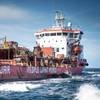Approaches for global FE modelling in the
shipbuilding industry, experiences in the application of analyses and
the implementation of CAD data were under discussion at a GL Exchange
Forum "Finite Element Modelling of Ships". More than 60 international
experts from European yards and engineering companies attended the forum
held in the headquarters of Germanischer Lloyd (GL) in Hamburg, Germany.
Even though the finite element method has been used in shipbuilding for
more than 30 years, modelling is still a current topic. Today, the most
efficient way is FE modelling from scratch, that is without or only
minimal utilisation of already existing CAD data. The reason for this is
the considerably different requirements regarding presentation of the
ship structure for design/construction (CAD) and global calculation
(FE). Therefore, the CAD manufacturers are currently working on a more
suitable CAD presentation of the ship structure which is supposed to
facilitate the direct use of the CAD data for the global FE modelling.
Rafael Doig, Thyssen Krupp Marine Systems (TKMS), gave an overview on
the procedure of global ship modelling and strength assessment as part
of the ship design process with TKMS. He highlighted benefits of the
described tool, showed possible improvement opportunities and opened the
discussion about finding an efficient analysis procedure.
Perti Arkke, Deltamarin, presented the application of NAPA STEEL which
is creating FE-models and automatic FE-net generator in coarse mesh
FE-models. He focused on the modelling and scaling of wave loads in
vertical and longitudinal strength in moment and shear force.
"The conflicting modelling requirements between FE computation and
assessment for global ship analysis" was discussed by Marc Wilken,
Germanischer Lloyd. "In general the assessment cannot be performed only
using the global finite element model and results - additional
information about structural details or loads are also needed", said
Wilken who also showed ways to handle these conflicts.
Thorsten Priebe, Germanischer Lloyd, highlighted the functionalities of
GL ShipModel. The pre-processor for generating FE models for global
strength and vibration analyses is based on MSC.Patran, a pre- and post
processor for CAE simulation. It features design-oriented functions that
allow fast and efficient modelling for containerships, bulk carriers,
tankers, naval vessels, ferries and motor yachts. Key features include a
raster philosophy for a user controlled subdivision of the model and
semi-automatic modelling of surfaces and curves with attached
structural.
Werner Kaufmann, MSC, gave a short introduction in the SimEnterprise
Product Suite and showed how feature "templates" can be used to do local
mesh refining on a global FE model in a user-friendly and time-saving
way.
Thomas Gosch, FSG, went into details about the comparison of forced
Vibration Results based on early and late Stage Finite Element Models.
Dr. Crerar Christie, QinetiQ, presented an outline of analyses at
QinetiQ Rosyth that indicate QinetiQ's approach to global ship
modelling, local modelling for crack analysis, and a structured approach
to the interchange of engineering data for design over
multi-disciplinary requirements.
Francisco Viejo De Francisco, NAVANTIA, informed in his speech about
"Recent developments in structural global analysis" and highlighted the
latest developments in structural analysis for naval. Special
requirements have to be implemented in the design of naval ships, for
example, underwater shock, internal and external blast, ballistic
protection and residual strength. Global analyses by means of finite
element are needed in the preliminary design phase to assess the impact
in the structure of operational requirements.
Sponsored Content
Chris-Marine’s solutions help to prolong engine lifetime

AST is now AST Networks, bringing you remote connectivity wherever you are

March 2024
 Read the Magazine
Read the Magazine

 Read the Magazine
Read the Magazine
This issue sponsored by:

Reagan National Defense Forum Highlights Uncrewed Maritime Systems
Subscribe for
Maritime Reporter E-News
Maritime Reporter E-News is the maritime industry's largest circulation and most authoritative ENews Service, delivered to your Email five times per week












